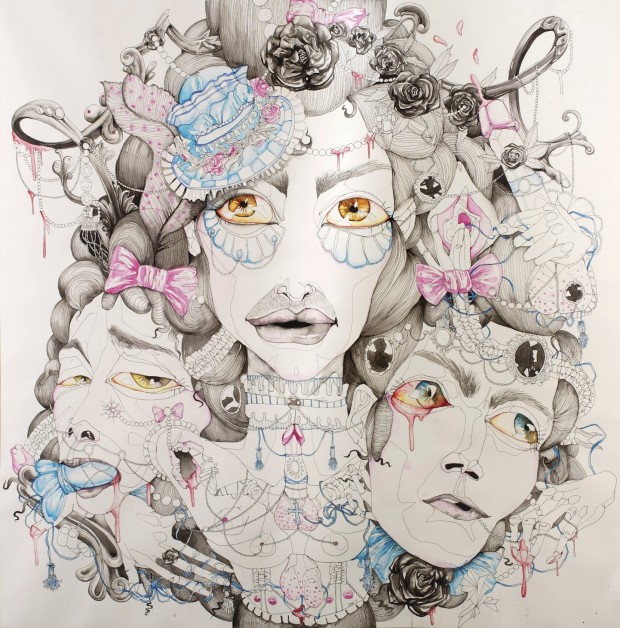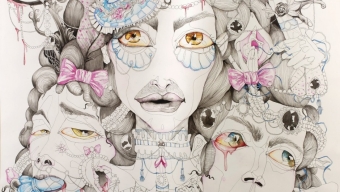NOIR NOTEBOOK
 On Thursday the 8th of September, a group show Drawing Time, curated by Daniel Smith, opened at GAFFA Gallery, in Sydney. The show features a collection of works by Sydney and Newcastle based artists including: Joel Beerden, Jo-Ann Cahill, Anastasia Freeman, Chas Glover, Grant Hunter, Amanda Kenneth, Gerant Kenneth, Sarah Mould, Patrycia Nedziak, Taryn Raffan, Eleanor Jane Robinson, Bran Sinclair, Daniel Smith, Daniel Tanner and Eduardo Wolfe-Alegria.
On Thursday the 8th of September, a group show Drawing Time, curated by Daniel Smith, opened at GAFFA Gallery, in Sydney. The show features a collection of works by Sydney and Newcastle based artists including: Joel Beerden, Jo-Ann Cahill, Anastasia Freeman, Chas Glover, Grant Hunter, Amanda Kenneth, Gerant Kenneth, Sarah Mould, Patrycia Nedziak, Taryn Raffan, Eleanor Jane Robinson, Bran Sinclair, Daniel Smith, Daniel Tanner and Eduardo Wolfe-Alegria.
The exhibition acted to survey a range of techniques and methodologies that are classed as drawings, yet across a broad range of mediums. Works on show were varied, though all artists’ shared a common thread and identified drawing as a large part of their practice. Types of work featured in the exhibition ranged from digital works to sewn textiles, sculptures, paintings, watercolours, books and prints. The shows curator Daniel Smith, suggested the ‘banner of drawing can be applied to the essence of the works not just for the mediums used to create them’, and it could indeed be argued that drawing is at the root of many different art forms.
The broad appeal of drawing lies in its expressiveness, precision and simplicity. The versatile role of strokes in covering form, tone, shape, texture and style are the source of both the richness and difficulty of the medium. There has been much recent discussion about the future of drawing in our ever increasing ‘digital world’, Drawing Time is reassurance that the practice of drawing is anything but a dead art form and is in fact being diversified and adapted by artists to suit more contemporary art practice.
This fairly recent spate of popularity of drawing as a contemporary art form could be at least partially attributed to the simple fact that drawing is relatively cheap. For struggling artists and students the high cost of studio space and materials can be daunting, drawing is a medium that is more financially viable as well as a manageable means of production. Furthermore, drawing is inclusive; with most people, even those who are insistent on their inability to ‘create’ having experienced the act of drawing on some level, a participation which affords even the most casual observer a sense of involvement in the medium. The growing popularity of zines and artists’ books as well as blogs are also reasons for this current interest and growth as drawings translate well online and reproduce well on paper.
Though each individual artists’ works within the group show were very different in style, they related well to each other and provided a broad view of contemporary drawing today.
Jo Ann Cahill’s Untitled series of soft watercolours were the first works to be seen in Gallery 1. Cahill’s pieces are washed watercolours on paper, usually focusing on a single figure. The images are generally taken from the Internet and then softened, so their meanings become construed or abstracted. The works are beautiful yet seem to possess a surreal and somewhat eerie characteristic to them.
Amanda Kenneth’s work ranges from large-scale paintings to intricately cut stickers made with street art collective DAg ARt. Needlepoint Nana reflects the current craft trend sweeping the contemporary art scene. The work is quirky and fun and her Nana would be sure to appreciate her fine crocheting skills.
Daniel Smith’s art practice revolves primarily around drawing. At times the drawings are done on paper but also take shape in painting and digital mediums. His digital video pieces were very well placed within this exhibition and aided in the inclusion of the viewer within the whole experience of drawing, thus inspiring us to feel creative too. The fairly simple act of filming an artists drawing practice was mesmerising to watch and one could be lost in the video for quite some time.
Sarah Mould’s porcelain characters added a cute and quirky element to the drawing show. Sarah likes to paint, draw and screen-print girls and boys and animals, that despite her best intentions, usually end up looking like a sleepy mix of cutesy and cat aids. These characters however, were a little more edgy than her usual works and I was surprised to hear that porcelain is a new world to her, as the works were well executed and rather charming.
You are the bird and the rabbit too by Patrycja Nedziak was instantly impressive. Her fine use of line and shading in simple graphite was visually effective and she captured the fear and vulnerability of the rabbit in exceptional detail. Nedziak’s work deals with tension dynamics, internal conflict and fear. She says of her work “when the persona splits into two and begins a battle, these drawings deal with the myth of the hero seeking out his greatest enemy and finding himself”.
It was hard not to be a bit taken by Eduardo Wolfe-Alegria’s visually striking work Menage a Trois (from La Petite Mort). Reminiscent in style to Del Kathyn Barton’s works, this large-scale work consisting of pigment ink and watercolour on paper was very impressive and managed to keep its own unique edge. Upon looking at the work for a little while, you began to notice semi-hidden images within the work, which encouraged a cheeky giggle.
Overall the exhibition flowed really well and provided an excellent look at the various forms the practice of drawing can take. It was nice to see a group of young and emerging artists using this form so well whilst constantly pushing boundaries and redefining what contemporary drawing can be and even should be.
An essay by Kate Finn
Featured image: Menage a Trois (from La Petite Mort) by Eduardo Wolfe-Alegria

The Kind Warmth Awaits – Geoff Roberts
November 03, 2014
Featured IG: @elsa_isabella
November 03, 2014
Zach Penhall – Sydney Music Photography
September 07, 2014
Jafflechutes: North America
April 09, 2014
ART PRINTS ASIA – Newsagency Gallery
February 22, 2014
Joel Beerden at Damien Minton Gallery 20/12
February 22, 2014
Black and White by Melinda Cartmer
January 08, 2014
The Magpie Song – The Paintings of Ben Cahill
November 24, 2013
Sloth Society – Tales From the Tea Room exhibition
November 24, 2013
Cosmic Cambodia
September 15, 2013
No News is Good News
August 04, 2013


















